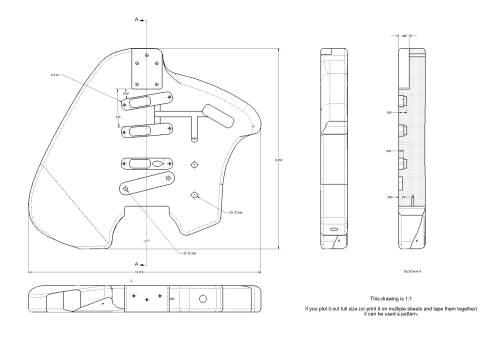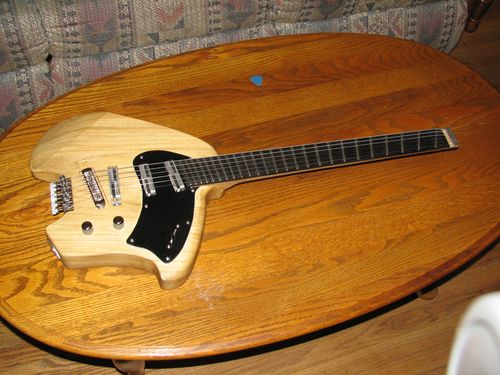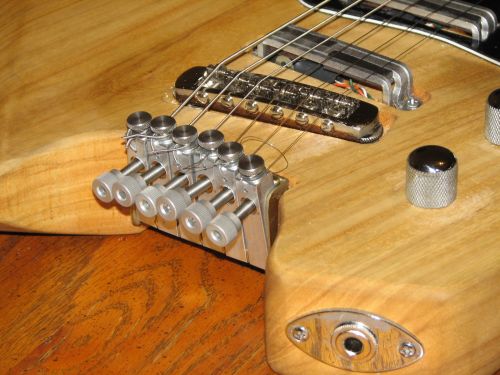Eric Olds Klein Guitar Project – Part 2
In part 2 of the Eric Olds Klein Electric Guitar Project, we take a look at the completed guitar and Eric’s headless tuner system. Also included are download links for plans to the Klein based guitar body and the tuning tailpiece.
The Guitar Body Plan
Eric generated full scale plans of the front and back of the guitar body and very generously made these available in Adobe Acrobat format for our readers. Here’s a preview of page 1 of the plan:

To download the plans, right click on the link below and choose to save:
Klein Electric Guitar Copy Plan.pdf – 366 KB
The Finished Guitar
The finished instrument features a primavera guitar body, a fanned fret maple neck and a fixed headless tuner solution of Eric’s design:

Lace Alumitone pickups are matched with a 5 position blade switch.
The Tuning Tailpiece
Eric’s tuner solution takes a number of off-the-shelf parts and transforms them into a tuning tailpiece or tailstop. Combining a Schaller roller bridge and a headpiece of extruded aluminum angle, it’s effective and lightweight. If you’re willing to forgo a tremolo bridge, the 2.6 oz roller bridge and 6 oz tuning tailpiece are a featherweight combination compared to the almost 1.5 lb Steinberger R-trem bridge.

For those interested in studying the tuning tailpiece further, right click on the link below and choose to save the six page PDF file:
Tuning Tailstop.pdf – 1.08 MB
Eric’s drawings cover everything you need to know to assemble one of your own and it looks good. I can certainly see myself considering it for a future guitar build.
Many thanks to Eric for sharing his build and his tuning solution!
Very nice natural wood body. Ingenious solution to the tuner assembly. Looks swell! I have heard that the extortionate prices for letting go of original Steinbergers bridges to Klein was part of that he put his shop on hiatus, they (Gibson, MusicYo) charged something like 800USD each for a S-trem bridge, and twice that for TT. On top of this Lorenzo fell very ill, and has still not recovered, if he is ever going to. Real catastrophic.
Little wonder then, that people are seeking their own solutions to bridge and tuner assemblies.
Anyone know of anyone who makes headpieces for Steinberger that are wider than stock?
Hi Mats –
With the ABM and ETS tuning tailpiece options – and even the Steinberger gearless tuners – one need not be too concerned about the Steiny trems anymore. Sure, these are all fixed bridges. That matters a bit. But at least there are parts available for headless guitars.
And regarding the headpieces; it is an option to fit a regular nut, extend the neck a wee bit, and attach one of the available headpieces there. The issue with nut width only comes into play if you require a zero fret, and therefore must mount the headpiece right at said zero fret.
My Forshage has 1 11/16″ and a zero fret. Chris found a quality headpiece on Ebay from an Asian vendor that fits just fine with that nut width.
@Mats – There’s always rolling your own in terms of the headpiece. Eric, for example, made one out of extruded aluminum angle.
Ok thanks. I want a 1 7/8 nut width. Just as with individual bridge tuners like ABM and similar (Status basses, but I think they’re ABMs as well) I think there ought to be individual headpieces as well. The space for fastening each of them may prove too narrow up there, it would fill the space pretty much up with drilling holes for each 6 of them. But I think, only then one could dabble with widths just as much as one liked to.
Very cool with the tuning tailpiece.
I’ve also always considered Alumitones a good “theoretical” match to an ergonomic guitar. First, due to light weight; but honestly, more due to aesthetic and sonic reasons. Somehow the idea of the “hi-fi” sound seems to match to a Klein-style guitar.
That said, the pickups Chris Forshage favours are more in line with vintage Jazz than “hi-fi”.
I say “theoretical” also because I don’t actually know how these sound. Anybody have any reports on the sound of the Alumitones?
Hi Greg,
I chose the Alumitones pretty much for those reasons. So far I like them. I do notice more of a bass response with them, and at least as much of the mids and treble as I’m used to. They are not all that high output, I’d say more medium. Another reason I installed them on this build is that they are not all that sensitive to distance from the strings- and since I wanted to directly mount the pickups to the body of the guitar and still fiddle with the action a bit, that was a help. Lastly, as the headpiece and tuning tailstop are mostly bare aluminum, the basic Alumitone pickup matched pretty well.
I still am curious how different the guitar might sound with a set of Joe Bardens (in this case the set for a Strat) would sound on this guitar.
Eric
@eric,
Any reason for slanting the bridge pickup totally opposite to the fanned fret design? I think, IMHO, pickups on a fanned fret instrument should follow each strings harmonics nodes up there.
I e should be slanted the same way the fanned frets are.
I e when picking harmonics, natural or artificial, and when having only on pickup active, certain harmonics will ring clear, put as you start to pluck harmonics “behind” the pickup the harmonics will disappear from “sight” or “sound”, because the harmonic nodes are slanted as well, but the pickups arent. compare this to have a neck pickup active on an ordinary guitar, and start to pluck harmonics behind it. They will not be picked up. However, the bridge pickup is way far back, so it will pick up most hamornics.
Now for some questions:
1. Any NOTICEABLE ergonomic benefits from the fanned fret neck?
2. Doesn’t bending on the first few frets turn out to be awkward, compared to a regular fretted guitar? I e the pitch doesn’t go up that high, or it stays at the same note.
/Mats
From an ergonomic point of view , extending the lower part of the body , would allow the guitar to stand/lean by itself ,So your poor back would have one less thing to carry to the gig and back … a guitar stand… every little bit helps us old guys…
Hi Mats,
For the direct questions:
1. Not really. Fanned frets don’t feel very different to me when I play.
2. I just went and plugged the guitar in to make sure before I answered- I bent strings at the 3rd fret, 12th and 19th, and didn’t notice any awkwardness- they felt and sounded about the same as my regular guitars-
With the slanting of the pickups, I did spend some time considering different options. For the neck pickup, I decided with 24 frets, I just wanted it as close to the end of the fretboard as possible, and that drove it to be slanted like the last fret. For the bridge, I did consider harmonics. In my CAD model I actually placed a tiny dot on each string where the node for each open string frequency should be, up to the 14th. The dots started to get pretty crowded near the bridge- My original goal was to make sure not to place the pickup directly under any node (as that would be a frequency where no string motion would be, and thus be invisible to the pickup) but found that they were so close together by the bridge, that the best I would be able to do is to choose the lower, and more common frequency nodes to avoid. Then it occurred to me that all my dots only represented the frequencies of open strings, and that as I fret a sting, all those nodes would move. I could not convince myself that I knew enough to favor one position or orientation over another and predict how it would affect the sound of the guitar. So I went with a more aesthetic choice- I put the bridge pickup ‘straight’ so it looked more like the bridge pickup on a Klein (Those seem to always be big humbuckers) and effectively angled it the same way to the strings as a Strat bridge pickup… The middle pickup was just set at an angle between the other two, to complete the look.
When playing, my girlfriend remarked that she could actually hear the difference between the pickup settings, where as with my other electric guitars, she’d not been able to notice them much.
Sharp idea on sourcing the parts. If somebody wants to drop the cost a bit (but stay above the 28 tpi range), they can go with McMaster-Carr 1/4-80 thumbscrews 97424A650 (~$38 savings) or even go with 3/16-100 set-screws 98625A230 (~$21 savings). The latter would need an allen key for tuning, but you’ll get a bit more precision/leverage. I’m not sure how hard it would be to turn a 0.4″ knob, in semi-tight quarters (I’ve got fat fingers) with about 27 lbs. on tension on the string, so that may be a non-issue.
Ray
I forgot to add, the McMaster-Carr 3/16-100 set screws have a ball bearing tip. That’s another plus.
Ray
Great solution on the bridge! I have been thinking about designing more of a Steinberger synapse style bridge using sourced parts but I like your idea better.
Question, I noticed you wrap the string around the base of the set screw and capture it with the shoulder of the screw. Doesn’t the 4-40 setscrew have enough force/grip to lock it in the hole?
Also how does the 100 TPI work out for the tension adjustment screw? Is it overkill or does it seem about right? I am interested in building a similar bridge and am modeling it in Pro/E right now any other suggestions or improvements you could recommend?
RZ
Hi Romano,
Thanks for the comments. As you guessed, my original intention was to clamp the sting using the 4-40 thumbscrew directly on the string passing though the hole. In practice, I couldn’t quite get it to work reliably. There would always be at least one string, usually the high E, that would get to a within a semi-tone of being in pitch, and then slip- very frustrating and not a practical tuning solution. Perhaps if I had used inserts or helicoils instead of just tapping the 4-40 thread into the aluminum. (I may yet do just that if I become unhappy with the thread life….) To make it work reliably, I found I needed more friction to augment the clamping. Wrapping the string over the tuning arm and around the screw does that. (And the upper E I wrap around the screw twice, just to be sure!)
As to the 100 thread per inch tuning screws, I think they’re the way to go. The first version I built used 1/4″-28 thumbscrews, (which were only half the cost) and did work- I played the guitar for a couple of months that way- but they were not smooth, it was sometimes difficult to tune the instrument precisely, and occasionally one would bind up and I’d have to use a pair of pliers to turn it! (I eventually found one of the screws had a damaged thread…) The 3/16″-100 are much, much better. It takes a little longer to bring the string up to pitch initially, but it’s so much easier to turn that you really don’t notice. And tuning is so much nicer, I’d say it’s definitely worth using the fancy screws.
Ray- I hadn’t noticed McMaster Carr had those- thanks! If you order their 3/16″-100 along with the bushing, though, it looks like it’s $1 a screw more expensive than the Thor Labs parts- and Thor offers a knob that fits with my scheme. (Plus they incuded ‘lab snacks’ in the package!)
Eric
@eric, Ok thanks that explains a whole lot.
Now, can the Alumitones give the same strat “quack” in those middle positions? I think, since they’re not sealed or waxed and very open construction, they would be even MORE prone to pick up noise and hum, than other regular pickups, but I am not sure. I know that most pickups of higher sensitivity and “hi-fi” sounding can pick up extraneous noise by themselves should they not be active.
Any thoughts on this, that you might share?
Hi Mats,
I’m afraid I’m probably not qualified to say much about strat “quack,” but I can speak to the noise properties of the Alumitones. They tend to be pretty quiet- Sitting here at the keyboard with the guitar plugged in, I notice almost no hum from the 21″ picture tube monitor. If I pick up the guitar and hold it next to the screen, at around 12″ or closer it becomes more obvious. (Depending on how much gain you’ve dialed in….) They’re not truly “noiseless” but they are a lot quieter than other single coils I’m familiar with, such as the vintage wound “toaster” pickups on my Rickenbacker. (At my seated distance from the monitor, the “toasters” put out more than twice the hum….)
Hope that helps-
Eric